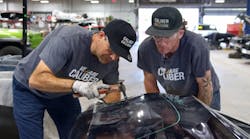Exploring an Expansion
Knowing when he was ready to expand was the easy part for DB Orlando Collision owner Drew Bryant.
“When we were parking on top of the sidewalks out front of the building,” Bryant says. “There simply wasn't enough parking.”
An overflowing lot is a good problem to have. But a problem is a problem nonetheless, and a business expansion can be a challenge for any owner to deal with for the first time. There are banks to deal with, business plans to draw up, research to do and, as in Bryant’s case, real estate to look for.
Matt’s Automotive owner Matt Lachowitzer is a veteran of many expansions in his mechanical and collision repair business. No two expansions are alike; it may involve renting vs. owning, adding on vs. building anew, and myriad financing options. Lachowitzer has only been in business since 2009 but has seen the financing environment change in numerous ways.
“Interest rates are today, much, much higher,” says Lachowitzer, who owns shops across Minnesota and North Dakota. “Banks are a little tighter than they used to be, need a lot more information. There's a lot of regulation and making sure you have all your ducks in a row, financials, projections. My first building compared to the stuff we buy now, they're a lot larger dollar amounts. Real estate values have gone up exponentially.”
Those “tighter” banks mean a little bit more scrutiny on an owner’s expansion plans. That’s where a business consultant like Nina Ross may come in handy. Ross has been a consultant since 2017 and also hosts a YouTube channel offering guidance on specific topics. At the time of this reporting, Ross was nearing the end of an expansion process with a client of hers, Brian Finger, who ran a remote diagnostics business in Houston.
FenderBender spoke to the shop owners and Ross about getting started in the expansion process and some potential pitfalls along the way. While a business consultant like Ross can certainly help move this process along, at the end of the day it’s on the owner to make the right moves for his or her business.
“The bank wants to know that you have 100% knowledge of your business,” says Ross. “Because if you can't talk about it, you don't know it. And if you don't know it, they don't believe that you can further the growth and development of a business.”
Consider Everything
As in Bryant’s case, knowing you’re ready for an expansion can seem like the easy part. Too much business and not enough space is simple math. But Lachowitzer also offers a word of caution that sometimes an owner’s existing space could be underutilized.
Before making a jump, owners should explore if there are any ways to increase their shop’s efficiency. That could look like longer days, double shifts, and swapping out crews, Lachowitzer says. And once a shop does decide to expand, it’s important to know there is enough staffing in place to support that.
“It may take time to fill these spots that you're going to create by expanding,” says Lachowitzer. “So start working on having a bench filled before you start a construction project, make sure you have a pipeline of people that you can bring in or bring in knowledge to get trained up for when that expansion is done.”
Once an owner decides to move forward with an expansion plan, everything is on the table. Ross says that one thing that often surprises owners is that a bank is going to evaluate personal credit as well as the financials of the business. If any issues need to be addressed in an owner’s credit, it should be done before moving forward.
“Your entire financial picture will be looked at,” says Ross. “If a client came to me and said that their personal credit was kind of shady, I would stop the process there. Because then you're wasting your time. It's either they may get a portion of what they want, or they will get some of what they want at a super high interest because of the personal.”
As for business financials, Ross says there is no magic number of growth or revenue a bank wants to see but they certainly want to see solid, sustainable growth. Shops that are “barely making it” may want to put the expansion on hold. Growth of 20% is a good estimate, Ross says.
Making a Plan
Solid financials need to be backed by a solid business plan. The more ambitious the plan, the more it may face scrutiny. In deciding to purchase a new space, Bryant settled on a former medical college. Obviously not already optimized as a collision repair facility, the building needed multiple floors torn down and office space demolished and turned into warehouse space.
“The bank thought I was out of my mind and essentially said, ‘This is not going to happen,’” Bryant says.
But Bryant was able to walk through why the facility would make sense and why his shop was ready to make such a move. He had KPIs to show how efficiently the shop operated and why the space would help maximize its earning potential. Those are the kind of things best answered by owners intimately familiar with the business.
While Ross’ diagnostics client gave her all the credit for developing his winning business plan, Ross herself says that a particularly savvy owner would be able to put one together on their own. She recommends doing some online research for a template, then filling in what you can, focusing on making sure the numbers are correct. If the bank can see the money in and money out, that’s a start.
“As a business leader, no, I would not go out right away and spend $15,000 on a business plan,” says Ross. “I will see if I could write it myself, and then maybe find someone who can finish it off for you.”
Ross says that in the actual meeting with the bank, she had to say very little. They wanted to hear from the business owner about why the plan was viable. Ross’ client, for example, is heavily into ADAS work which she says is a relatively unexplored market in Houston. That helped secure the financing.
“Before you go to the bank, before you do anything, have all your financials and your projections and your acquisition costs of equipment and all the other pieces that are going into equipping this building, and marketing, and everything that you're going to need to fill that extra space,” says Lachowitzer. “Really have a plan together when you go to the bank.”
The Next Steps
Every situation is unique, and there may be more back and forth between bank and business, Ross says. Once the funds are delivered then the rest of the project can proceed, whether that’s adding onto a building or looking for a new space. Bryant was able to find his new space in an unusual way.
A member of Bryant’s 20 Group gave him the advice that when he went out to dinner with his wife, to eschew a table for the bar and have conversations with the other patrons about what business they were in. After three weekly attempts, Bryant lucked into a meeting with someone in commercial real estate, and suddenly he had access to all sorts of options his realtor wasn’t finding.
“It was amazing at how many more of those relationships kind of kept coming back up,” Bryant says, adding that other people he’d met were helpful in other areas such as someone in site development. Sharing info and building relationships can be a big help in what can be a frustrating and long-term process.
And once the financing is done does not mean the easy part is over. Ross gives an example that a site her client fell in love with turned out to have a future highway expansion planned to run right over it within five years. Think long-term; patience and due diligence can help ensure owners don’t make a permanent mistake.
The waiting for the job to be done can be long, and owners handle it in different ways. Lachowitzer says he’s not the kind of guy who can be on a construction site each day. Bryant says the opposite. He even had a blueprint he hung up in his shower to look at and plan each morning. If the preparation was all in order, the payoff will be worth the trouble.




